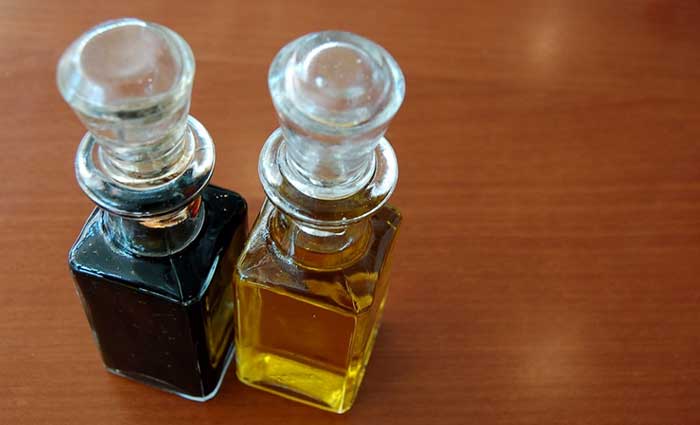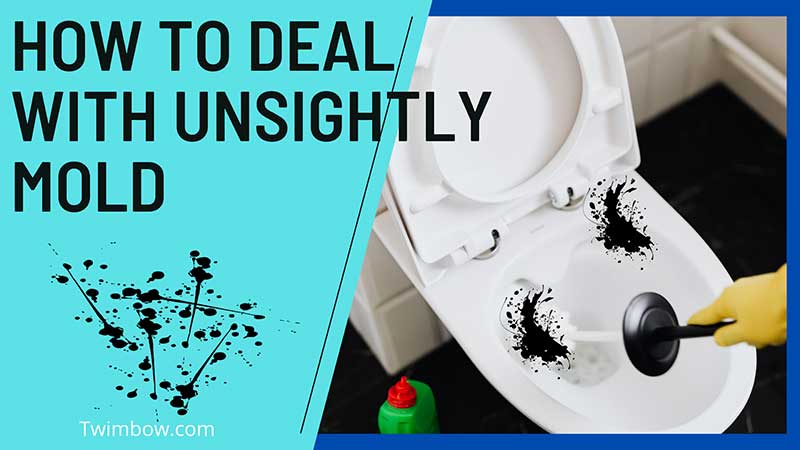Mold is a black unwelcoming sight mostly found under the toilet rim. While it doesn’t stop anyone from using the toilet, it can be cringe-worthy and when uncontrolled, result in mold allergies, rashes, nausea, asthma attacks, lung infections, headaches, dizziness, and shortness of breath.
Mold reproduces faster in dark and humid conditions. The human waste and dust particles that stick inside and outside the bowl provide the needed food for their development. This means, proper and frequent cleaning can be a weapon enough to keep this growth at bay.
If left unattended, mold can become a real menace. Thankfully, there are multiple ways to get it under control. Read on to know all the possible ways you can remove and stop mold and mildew growth.
1. Vinegar (best solution for simple mold)

They say there is no problem a duct tape can’t fix-including sealing blubbering mouths (pun intended). Well, guess what, Vinegar is another magical solution to almost all home problems. Being a natural substance, vinegar is ideal for those who obsess over keeping the structure of their toilets intact. Abrasive solutions, on the other hand, can cause a lot of costly damages.
How to use vinegar to clean toilet mold?
On its own, vinegar is not powerful enough to unstick mold from the toilet bowl and tank. You’ll need baking soda as well. To start, down a cup of vinegar in both the toilet tank and bowl. This ensures mold in the tank and bowl will be taken care of.
Next, sprinkle a few amounts of baking soda in the bowl and around the rim. Close the lid once fizzling starts and let it stay that way for about an hour. Mold has now been tenderized but still stuck on the walls. So scrub the toilet bowl gently with a non-abrasive toilet brush making sure to splash some of that vinegar water all the way under the rim.
Close the lid and let the mixture work up the mold for roughly 15 minutes. At this point, most of the mold has been obliterated and it’s okay to flush. Use the toilet brush once again to scrub any visible mold. Use a piece of cloth soaked in vinegar on outside areas of the bowl and tank.
Tip: you don’t have to wait until a week or two to clean out mold again. A simple practice of pouring a cup of vinegar in your toilet tank a couple of times a week will help to keep even the nastiest black mold away.
2. Bleach (best solution for stubborn mold)
Listen; we highly recommend using vinegar and baking soda combo. However, if you’ve been out of your home for long or haven’t used your toilet in ages, chances are high you are facing an unflinching mold. Believe it when we say, you’ll pull out your hair trying to get rid of stubborn mold. The best solution here (which should be done only once) is the use of good ol’ bleaching agents.
How to use bleach to get rid of toilet mold?
Because of its corrosive nature, you need to dilute bleach (mostly chlorine) with water in a widely recommended ratio of 1: 10 (1 bleach, 10 parts water). You can use a disposable bottle or spray can to whip up this concoction.
Full disclosure; insanely sticky mold means making a much stronger brew with more parts of bleach. So keep that in mind in case the ratio of 1:10 fails to clean out mildew growth.
Now, with the spray bottle loaded, sprinkle the mixture inside the toilet bowl and all the way into the rim. Add some to the toilet tank as well. Stir the mixture, close the lid and give it an hour for the magic to happen.
The hour has elapsed. Open the lid and give your toilet bowl and tank a good but gentle scrub until all the threat is eliminated. Now flush the toilet-a couple of times if need be until you can almost see its once pristine shine. Use some of that bleach concoction to wipe the exterior parts of the seat, bowl, and tank.
Be sure to pour a mixture of bleach inside the tank once a week to deal with any lingering mold before it grows into a tedious, time-consuming responsibility.
Warning: don’t use steel wool pads or anything metallic to scrub your toilet. Doing so will result in a dull and weakened toilet bowl.
Why you should not use bleach often?
We already said bleach comprises chemical compounds that are abrasive to the toilet structure. Secondly, if you have toddlers that are still crawling, you might want to avoid this method or lock the toilet tight after cleaning.
3. Using a Handheld Steam Cleaner
Did you know that a steam cleaner can be used to get rid of mold growth? Well-now you know. This method is not only simple but chemical-free as well. On top of that, your bathroom will be sanitized and therefore super-safe for young ones.
How to get rid of mold using a steam cleaner?
Plug your steam cleaner into a power source and let it heat up for a minute or two so you have the best but hottest seething temperatures. Now grab the blower/nozzle and direct it to all the areas with mold and mildew growth.
Once you are done steaming, flush the toilet and use damp cloths on exterior surfaces. Repeat the process for any mold stains that are still visible.
4. Using Laundry Additive
We know the sound of laundry additives going into your toilet might sound weird but it’s also another capable way of dealing with mold. Examples of additives to consider include EC3, and Citrisafe Remedy.
How to remedy toilet mold using a laundry additive?
Fill a spray can with the laundry additive of your choice. Spray the parts of the toilet where mold is present. You should then let the toilet rest for about an hour so the laundry additive can weaken mold. Afterward, scrub the toilet with a gentle brush ensuring to spread the additive mixture to all the hidden areas of the bowl. Close the lid and allow for 15 more minutes of soaking.
Once the 15 minutes are over, flush the toilet. You can repeat the process for areas with stubborn mold.
5. Toilet Mold Cleaners
There are multiple specialized products crafted to stop mold in their tracks. These are majorly chemical-oriented and therefore best left as last resort. Chemicals are not friendly for kids and they emit fumes that can trigger allergies, seizures, and other conditions. Be sure to take the necessary precautions to keep yourself and your family safe.
You can also try out magic erasers to get rid of toilet mold. They are already handy for doing away with toilet rings so yes-they can effectively handle any toilet growth. To use it, simply dissolve it in the toilet tank and bowl, let it rest for about 15 minutes, and start scrubbing.
How to stop mold growth on your toilet?
There is one solid solution to keeping mold away; wash your toilet frequently. This is a no-brainer, of course. Just make sure you wash both your bowl and toilet tank.
Frequent cleaning only takes care of the organic matter-that is waste material that serves as food for mold. However, improper lighting too is a huge mold growth agent. So you need to try and find ways to allow for maximum light into your bathroom.
The next thing you need to take care of is humidity. Too much moisture propagates mold growth. The solution here is to look into toilet fans that suck any lingering water droplets in the air. Like we said before, pour a cup of vinegar or bleach down the toilet tank once a week to kill any tiny traces of mold and mildew growth.
Wrap Up
There are many effective ways of getting rid of toilet mold. And the best part is, you don’t even need to call in a plumber. The steps are straightforward and you probably already have all the toilet cleaning solutions. If not then you should be able to find everything in a nearby store.
Do not resort to harsh mold cleaning solutions. They will dim the lustrous surfaces and trigger corrosion of the tank’s parts. Continued use of harsh chemicals will lead to frequent toilet repairs and costly replacements that could have been avoided. In case of serious damages, be sure to scout for the best toilet repair kits.
Also, understand that mold growth can be a way of telling you that you need to fix or get a new bathroom fan. Alternatively, it could be that you need to increase lighting as it is mold-unfriendly. If your toilet has had a good run, don’t stress so much. Check out some of the greatest toilets from our blog posts. Happy cleaning!

